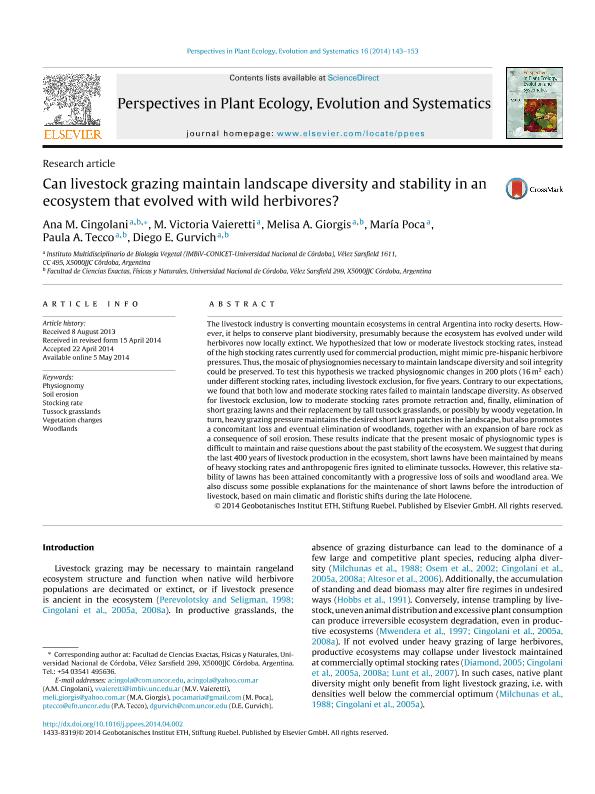Mostrar el registro sencillo del ítem
dc.contributor.author
Cingolani, Ana María

dc.contributor.author
Vaieretti, Maria Victoria

dc.contributor.author
Giorgis, Melisa Adriana

dc.contributor.author
Poca, María

dc.contributor.author
Tecco, Paula Andrea

dc.contributor.author
Gurvich, Diego Ezequiel

dc.date.available
2017-08-16T19:07:07Z
dc.date.issued
2014-06
dc.identifier.citation
Cingolani, Ana María; Vaieretti, Maria Victoria; Giorgis, Melisa Adriana; Poca, María; Tecco, Paula Andrea; et al.; Can livestock grazing maintain landscape diversity and stability in an ecosystem that evolved with wild herbivores?; Elsevier Gmbh; Perspectives in Plant Ecology Evolution and Systematics; 16; 4; 6-2014; 143-153
dc.identifier.issn
1433-8319
dc.identifier.uri
http://hdl.handle.net/11336/22535
dc.description.abstract
The livestock industry is converting mountain ecosystems in central Argentina into rocky deserts. However, it helps to conserve plant biodiversity, presumably because the ecosystem has evolved under wild herbivores now locally extinct. We hypothesized that low or moderate livestock stocking rates, instead of the high stocking rates currently used for commercial production, might mimic pre-hispanic herbivore pressures. Thus, the mosaic of physiognomies necessary to maintain landscape diversity and soil integrity could be preserved. To test this hypothesis we tracked physiognomic changes in 200 plots (16 m2 each) under different stocking rates, including livestock exclusion, for five years. Contrary to our expectations, we found that both low and moderate stocking rates failed to maintain landscape diversity. As observed for livestock exclusion, low to moderate stocking rates promote retraction and, finally, elimination of short grazing lawns and their replacement by tall tussock grasslands, or possibly by woody vegetation. In turn, heavy grazing pressure maintains the desired short lawn patches in the landscape, but also promotes a concomitant loss and eventual elimination of woodlands, together with an expansion of bare rock as a consequence of soil erosion. These results indicate that the present mosaic of physiognomic types is difficult to maintain and raise questions about the past stability of the ecosystem. We suggest that during the last 400 years of livestock production in the ecosystem, short lawns have been maintained by means of heavy stocking rates and anthropogenic fires ignited to eliminate tussocks. However, this relative stability of lawns has been attained concomitantly with a progressive loss of soils and woodland area. We also discuss some possible explanations for the maintenance of short lawns before the introduction of livestock, based on main climatic and floristic shifts during the late Holocene
dc.format
application/pdf
dc.language.iso
eng
dc.publisher
Elsevier Gmbh

dc.rights
info:eu-repo/semantics/openAccess
dc.rights.uri
https://creativecommons.org/licenses/by-nc-sa/2.5/ar/
dc.subject
Physiognomy
dc.subject
Soil Erosion
dc.subject
Stocking Rate
dc.subject
Tussock Grasslands
dc.subject.classification
Bioquímica y Biología Molecular

dc.subject.classification
Ciencias Biológicas

dc.subject.classification
CIENCIAS NATURALES Y EXACTAS

dc.title
Can livestock grazing maintain landscape diversity and stability in an ecosystem that evolved with wild herbivores?
dc.type
info:eu-repo/semantics/article
dc.type
info:ar-repo/semantics/artículo
dc.type
info:eu-repo/semantics/publishedVersion
dc.date.updated
2017-08-01T13:58:23Z
dc.journal.volume
16
dc.journal.number
4
dc.journal.pagination
143-153
dc.journal.pais
Alemania

dc.journal.ciudad
Berlín
dc.description.fil
Fil: Cingolani, Ana María. Consejo Nacional de Investigaciones Científicas y Técnicas. Centro Científico Tecnológico Conicet - Córdoba. Instituto Multidisciplinario de Biología Vegetal. Universidad Nacional de Córdoba. Facultad de Ciencias Exactas Físicas y Naturales. Instituto Multidisciplinario de Biología Vegetal; Argentina
dc.description.fil
Fil: Vaieretti, Maria Victoria. Consejo Nacional de Investigaciones Científicas y Técnicas. Centro Científico Tecnológico Conicet - Córdoba. Instituto Multidisciplinario de Biología Vegetal. Universidad Nacional de Córdoba. Facultad de Ciencias Exactas Físicas y Naturales. Instituto Multidisciplinario de Biología Vegetal; Argentina
dc.description.fil
Fil: Giorgis, Melisa Adriana. Consejo Nacional de Investigaciones Científicas y Técnicas. Centro Científico Tecnológico Conicet - Córdoba. Instituto Multidisciplinario de Biología Vegetal. Universidad Nacional de Córdoba. Facultad de Ciencias Exactas Físicas y Naturales. Instituto Multidisciplinario de Biología Vegetal; Argentina
dc.description.fil
Fil: Poca, María. Consejo Nacional de Investigaciones Científicas y Técnicas. Centro Científico Tecnológico Conicet - Córdoba. Instituto Multidisciplinario de Biología Vegetal. Universidad Nacional de Córdoba. Facultad de Ciencias Exactas Físicas y Naturales. Instituto Multidisciplinario de Biología Vegetal; Argentina
dc.description.fil
Fil: Tecco, Paula Andrea. Consejo Nacional de Investigaciones Científicas y Técnicas. Centro Científico Tecnológico Conicet - Córdoba. Instituto Multidisciplinario de Biología Vegetal. Universidad Nacional de Córdoba. Facultad de Ciencias Exactas Físicas y Naturales. Instituto Multidisciplinario de Biología Vegetal; Argentina
dc.description.fil
Fil: Gurvich, Diego Ezequiel. Consejo Nacional de Investigaciones Científicas y Técnicas. Centro Científico Tecnológico Conicet - Córdoba. Instituto Multidisciplinario de Biología Vegetal. Universidad Nacional de Córdoba. Facultad de Ciencias Exactas Físicas y Naturales. Instituto Multidisciplinario de Biología Vegetal; Argentina
dc.journal.title
Perspectives in Plant Ecology Evolution and Systematics

dc.relation.alternativeid
info:eu-repo/semantics/altIdentifier/url/http://www.sciencedirect.com/science/article/pii/S1433831914000407
dc.relation.alternativeid
info:eu-repo/semantics/altIdentifier/doi/https://doi.org/10.1016/j.ppees.2014.04.002
Archivos asociados
